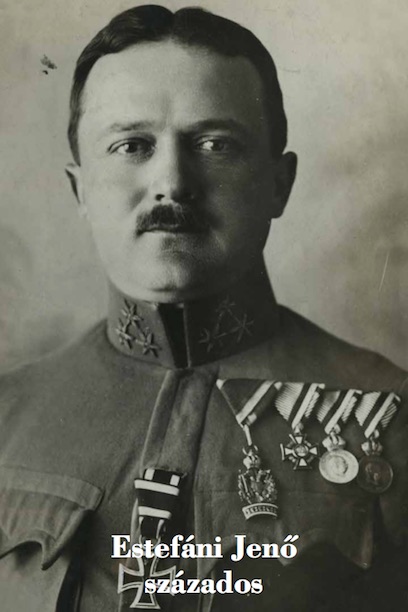The dissolution of the Austro-Hungarian Monarchy plunged the Kingdom of Hungary into its deepest crisis since the Ottoman occupation.
For Hungarians the trauma of the lost war was particularly painful after the promising first years of the 20th century. The situation of the Kingdom of Hungary – which after the Compromise of 1867 with Austria became a constituent part of the Austro-Hungarian Monarchy – was more favourable that at any time since the days of the Árpád dynasty in the 13th century. After decades of growing prosperity, the lost war and the dissolution of the old world left it in a vacuum. Before abdicating from the imperial throne, its king, Blessed Charles IV, issued a declaration inviting the nations of the Empire to take their destinies into their own hands. While the armies of neighbouring nations invaded Hungary to grab more territory, the Hungarian state sank into a deep crisis of legitimacy. After the assassination of Count István Tisza an attempt was made to set up a parliamentary republic, and then from March 1919 to the end of July the Hungarians went through the horrors of four months of communist proletarian dictatorship. The crisis of leadership continued from 1918 to 1920, and a permanent state of emergency raised the spectre of the end of one thousand years of Hungarian statehood. Count Mihály Károlyi, who was elected President of the Republic, was expected to negotiate fair peace conditions which would take into consideration Hungary’s national interests. But Károlyi’s sympathies lay with internationalist socialist ideals, and he demobilised Hungary’s armed forces. Meanwhile the invading foreign armies met no resistance in their drive to occupy vast swathes of Hungarian territory. During the 133 days of the Soviet Republic, led by Béla Kun, Hungary was subjected to the Red Terror, which was followed by another wave of violence in response: the White Terror. As a result of the enforced peace of the Treaty of Trianon, Hungary became the biggest loser of World War I: one third of the Hungarian-speaking population found themselves outside the country’s borders, and Hungary lost two thirds of its territory. Refusing to live as the citizens of foreign countries, hundreds of thousands of Hungarians fled to what remained of Hungary. These were the so-called “railway wagon dwellers”. Many of them led a miserable life in railway wagons, right up until the end of the 1920s. Hungary plunged into near-civil war conditions. During the two years immediately after the war what was at stakes was survival itself.
◆
„They begin with Transylvania, and after some insults flung like tennis balls between Tardieu and Lansing. Hungary loses her south. Then Czechoslovakia, and while the flies drone in and out of the open windows Hungary loses her north and east. Then the Jugo-Slav frontier, where the Committee’s report is adopted without change. Then tea and macaroons."
Harold Nicolson
„No country has been destroyed more viciously than Hungary was at Trianon. "
Francesco Nitti
„The whole documentation that we received from our allies at the peace talks was deceitful and untrue. We came to a decision on false premises."
David Lloyd George
„Eighty per cent of wagon dwellers came here out of patriotism."
Budapesti Hírlap, November 9, 1920
„In railway stations across Hungary there are 3,750 carriages full of wagon dwellers; 1,500 of them are in Budapest, of whom 810 live in wagons at Nyugati railway station."
Az Est, November 10, 1920
„Ten thousand people spent the harsh winter of 1920/21 in improvised wagon camps."
Ellenzék, February 22, 1925
„At that time Debrecen still hosted many wagon dwellers, who had come both from Transylvania and northern Hungary, and whose mere presence warned us of our country’s tragedy."
Magda Szabó
„We should not be afraid of spilling blood. If necessary, we shall exterminate the entire bourgeoisie."
Tibor Szamuely
„Hungary has been invaded by the Serbs in the South and by the Czechs in the North West. We are defenceless against the invaders."
Budapesti Hírlap, November 12, 1918
Prayer book, rosary, holy water vial
Women’s jewellery
Vintage decorative table with photographs of Charles IV and Queen Zita
(László Makai)
Porcelain plate and soup dish decorated with an image of the Holy Crown
(Ministry of Defence, Military History Institute and Museum)
Franz Joseph’s death was felt as a tragedy by his contemporaries.
The military casualties of the war numbered 10 million dead and 21 million wounded.
The victors invoked the principle of “national self-determination”, but their decisions bore no trace of this.
After World War I the United States took over the leading role in world politics from Europe.
The continent’s victors and vanquished alike faced similar problems: everyday life was overshadowed by social unrest and economic hopelessness.
In three devastating waves, the pandemic killed over twenty million people: more than twice the number of soldiers killed in the war.
The organisation founded at President Wilson’s initiative was the first attempt at peaceful resolution of the world’s conflicts.
Violence and intimidation were from the very start the essence of communist dictatorships.
Attempts at transforming European societies and the threat of a communist world revolution posed a serious challenge to European states.
“Divide and rule!” The victors redrew the world map in a way that would possibly perpetuate ethnic and religious conflicts.
The dissolution of the Austro-Hungarian Monarchy plunged the Kingdom of Hungary into its deepest crisis since the Ottoman occupation.
Tisztelt Látogató!
A kommunista vezetőket bemutató adatbázisunk az 1989-ben megjelent Segédkönyv a politikai bizottság tanulmányozásához című kötet online változata.
A jelenleg 532 életrajzot, 6902 kronológiai adatot, valamint 990 bibliográfiai tételt tartalmazó digitális adattár folyamatosan bővül, így a Kommunizmuskutató Intézet megkezdi az állampárti diktatúra többi irányító szervezetére, azok képviselőire vonatkozó adatok összegyűjtését és publikálását.
A több évet igénybe vevő kutatómunka eredményeképp bemutatjuk majd a korszak parlamenti képviselőit, az Elnöki Tanács, a Minisztertanács, a Szakszervezetek Országos Tanácsa, a Hazafias Népfront, valamint a KISZ Kb stb. vezető testületeinek tagjait.
Tovább